Last Updated on 11/19/2020 by Desmond
Most of the countries with tea culture almost take green or black tea as the mainstream. But in China, the place tea was born, a kind of tea named Pu’er(also called Pu-erh tea) is the most popular.
Even though culture and dietary habits are different, the delicious taste of aged food seems to be loved by people worldwide. Just like wine and cheese, Pu-erh tea also gets a deeper level of flavor by aging. The longer it aging, the taste will be better, and the cost higher.
But Pu-erh is a special leaf; even the Chinese can not understand it completely. Why? Because of its broad definition. The most we know is the compressed dark tea in the tea store. But in fact, Pu-erh tea refers to all the teas originated in Yunnan, China, including all the tea types such as green and black.
There is no denying that Pu-erh tea’s market is huge. The enormous benefit brings chaos; some tea lovers may feel confused when buying.
This article will help you with a simple understanding of Pu-erh tea. About the serious and official studies, give them to the more professional scholar.
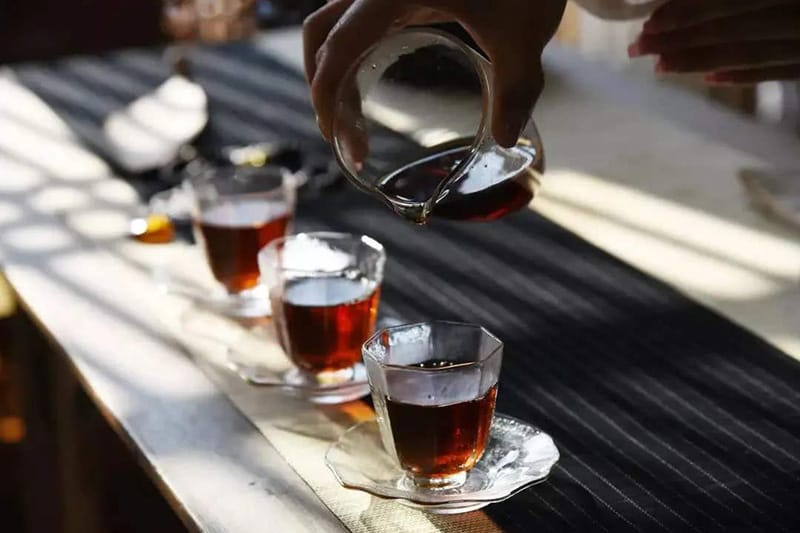
CONTENT
Pu-erh Tea Brief Introductions
History
The recognized earliest Pu-erh tea record was in the Tang Dynasty, an ancient document told that there already had tea-cultivate and drinking habits at that time. This type of tea tree was called Yunnan large-leaf tea tree later(Pu-erh type.) What is worth knowing, this plant is the same as the Assam Camellia Sinensis.
The most ancient Pu-erh processing is similar to green tea, which has to been fixated, rolling, and drying into rough tea. It is also called raw tea, can be brew directly and sold in loose-leaf tea style. Yunnan was one of the Ancient Tea Horse Road starting points; the tea trading is the most important thing.
Raw tea was not suitable for a long journey because the traffic was terrible in the old-time. So the tea masters will steam the leaves soft again and compress them into a bowl or cake shape, then drying again and packing for sale. This intelligent method extends the Pu-erh tea shelf life a lot and can save more shipping space.
Of course, the steam and compress work will not stop the tea from going bad wholly. During the long journey, most leaves were gone bad by the hostile environment. Fortunately, people found some tea cakes even looks already bad, but the brews become more attractive. It tastes more mellow and less grassy smell.
Tea merchants feedback this information to the Yunnan tea masters. After some research, they found that the Pu-erh tea will get dark and a significant change of flavor after aging in a proper environment for a long time. The longer it aging, the more dramatic the change. Therefore, people started aging Pu-erh tea designedly, for 5 years, 10 years, even dozens. It is the so-called Aged Raw Pu-erh Tea.
And this process is also called post-fermentation, which is the most different between dark tea and others. As society and science developing, people know more about microbial activities, the consumer demand for Pu-erh tea was also growing. In 1973, a new tea processing method was invented by the Chinese tea masters, which is called Pile Fermentation(Piling, Wo Dui.)
During the piling process, tea masters pile the leaves into a heap on the ground, add microorganisms artificially and keep watering to speed up the fermentation. Besides, it can also help unify the tea quality and reduce the long-time aging work’s uncertainty. The tea which had been piling fermentation is called Ripe Pu-erh Tea.

Dispute. What Is Pu-erh Tea Belongs To?
The recognized tea classified way is according to the processing. That makes Pu-erh tea in a dispute situation.
First, there is no doubt ripe Pu-erh belongs to post-fermented dark tea because it had been piling. What is disputed is about the raw Pu-erh, which is processed from the sun-drying rough tea. This rough tea’s processing, looks, and infusion color all close to green tea; the steaming and compressing job will change nothing but the shape. So people also called it sun-drying green tea.
However, the rough tea will be withering for a while before they fixation; that leads to a slight fermentation. So it can not be classified as green, strictly speaking. Also, the Pu-erh rough tea’s picking standard is one bud and multiple leaves, not like green tea prefer the tender buds. And about the flavor, the fresh raw Pu-erh taste a strong grassy, astringency, and stimulating, even some spicy. That is much different from the green tea’s slight sweetness.
You may say that seems not to be a big problem. In fact, the dispute mainly from the tea merchants. Pu-erh tea is too prevalent in China; it cracks down on the market of other types of tea a lot.
Especially the dark tea market. When people are talking about buying dark tea, they mostly mean the ripe Pu-erh. Even though Liu Bao tea and Anhua dark tea also good.
The same condition happened on the Moonlight White tea, which origin in Yunnan too. Because its leaves are from a large-leaf tea tree and look much different from ordinary white tea, many tea merchants are not regarded it as white but Pu-erh.
Besides, Yunnan tea masters produce all the other tea types with large leaves, and they also have good quality. Most other tea merchants and Yunnan themselves both hope to let Pu-erh independent from the 6 tea types classification. But it will cause many relevant problems and are not carried out till now.
Chaotic Market
In fact, the hot trend of Pu-erh tea was hyped up by the merchants to a certain extent. About 10 years ago, the excellent weight loss benefits and the aging value were the primary promotion means of Pu-erh tea. It is said that some have been aging for over decades raw Pu-erh teas were under the hammer with a sky-high price.
The great demand made the market into chaos. At first, only the tea origin from Yunnan and made from large-leaf tea trees ability to be called Pu-erh. However, many illegal merchants produce tea cakes with the leaves from other places, brand it Pu-erh, and cheating selling.
Due to the complex Pu-erh types, customers are easily buying fake products. Besides, the quality and pricing of aged Pu-erh tea only can be judge by a personal feeling; it also leads to a high premium.
Fortunately, with the craze fever gone, the Pu-erh tea price tends to be stabilized gradually. At the same time, customers knowing Pu-erh deeper, many illegal merchants and fake products lost their market.
Besides, to satisfy more people’s taste, tea masters also keep developing Pu-erh tea processing and types. My favorite is a kind of ripe Pu-erh, which is put the leaves in a dried tangerine and let them aging together; we called it Tangerine Pu-erh. Both of them are famous Chinese aging food. After a long time of interaction, leaves will get charming fruity.
Pu-erh Tea Varieties And Characteristics
The flavors of various Pu-erh tea sold on the market are very different. If you buy without any preliminary knowledge, you may get the taste you do not like and make a bad impression. It’s necessary to know more about the common Pu-erh teas’ varieties and characteristics.
Classified By The Processing
To classify Pu-erh tea by their processing ways is the most primary and easy. That is what we said Raw Pu-erh and Ripe Pu-erh.
Raw Pu-erh Tea
Raw Pu-erh tea is also called Sun-drying tea. After the picking job, leaves will be withering under the sun for a while, then sent to fixation and rolling. Finally, put them under the sun for drying again, to make rough tea. The rough tea is loose leaf this moment; tea farmers will sell them to the tea factories for further processing, less part for sold directly.
After purchasing rough tea, tea factories will steam them soft, then compressing them into various shapes by the machine. These final products are Raw Pu-erh tea. You can store it to let it aging or drink it directly, but the fresh raw Pu-erh taste very spicy.
Typically raw Pu-erh tea looks dark green, and the infusion is yellow-green. You may be confusing it with green tea if the leaves are not such big. Even though its pressing is similar to green tea, its flavor is more intense. The fresh raw Pu-erh tastes an intense grassy and astringency. After the infusion slips down your throat, it will leave a cool feeling behind your oral.
The raw Pu-erh tea, which after aging, both the infusion and leaves color will get darker. And the taste will change into mild gradually, just like the ripe grain, and the grassy gone. The longer it aging, the much change. About the specific flavor, it depends on how you aging, the methods, and so on. So there are many possibilities for the flavor changes, and this is the charm of aged Pu-erh.
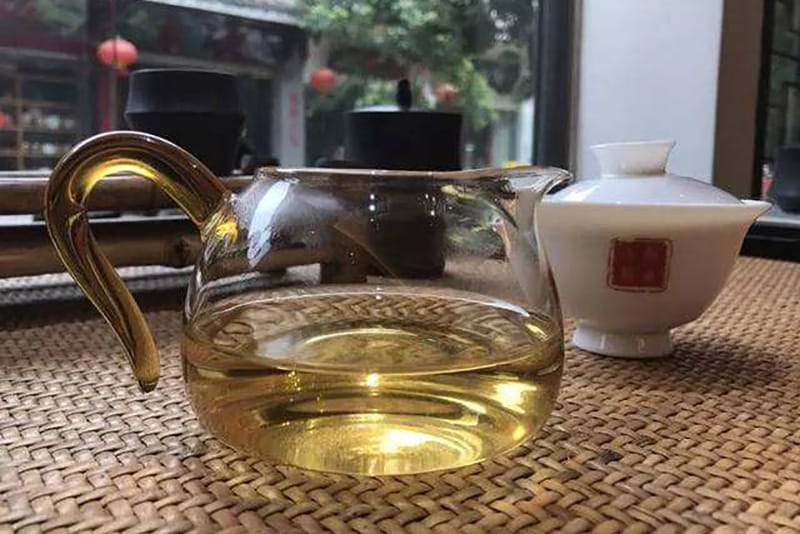
Ripe Pu-erh Tea
Ripe Pu-erh takes the raw one as the basic, plus a step called piling in the processing. Tea masters will place the rough tea on the ground indoors, keep adding water and microorganism to them for a period of time. Piling is for simulating the aging environment to speed up the fermentation.
At the first time, ripe Pu-erh is not acceptable to tea lovers; they thought it is a cheat. Later, ripe Pu-erh won their respect for its excellent quality and taste. The biggest pro of it is to reduce the aging work much, makes the tea lovers avoid the loss from a wrong aging way. And the quality also easy to uniformly control.
Ripe Pu-erh looks dark brown, and the infusion shows coffee. It tastes much different from the raw one. Without any pungent, tastes smooth and mellow, with a little sweetness, sending a ripe grain aroma. What is worth knowing, even though ripe Pu-erh’s fermentation similar to the aged raw Pu-erh, they still taste different. And ripe Pu-erh also can get deeper flavor by aging.
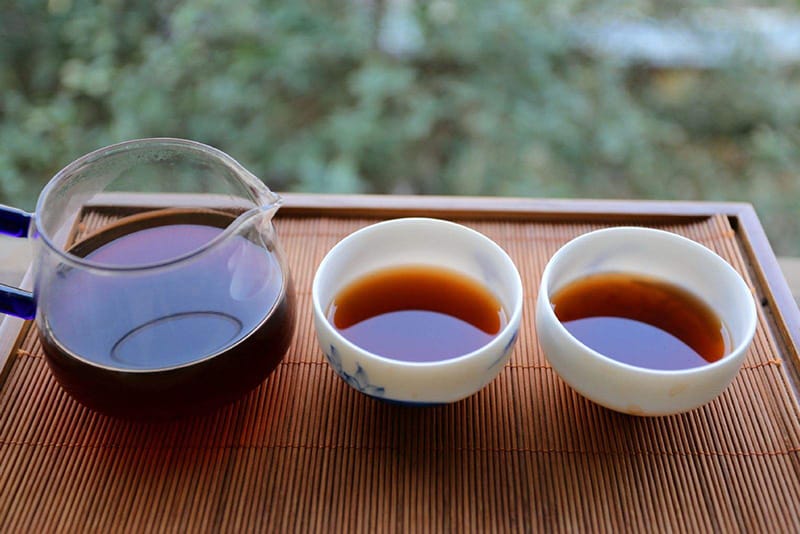
Classified By The Aging Way
Whether raw or ripe, most tea factories will do a certain aging job before selling, typically for 1 year or more. And some tea merchants, for enhancing the quality and price, also aging them for a time and graded them by the time cost. Take care of the note on the product package; it will show how long it has been aging, 3, 5, 10 years, or more. Of course, it also may be a cheat. And according to the aging way, Pu-erh is also classified into Dry-aging and Wet-aging.
Dry-aging Pu-erh
It means to follow the traditional aging way, store the Pu-erh at a dark, ventilated, and dry warehouse, to let it ferment naturally.
Wet-aging Pu-erh
It means to store the Pu-erh in a moist place, such as a cellar, to speed up the fermentation. But if not control the temperature and humidity well, it will lead to moldy.
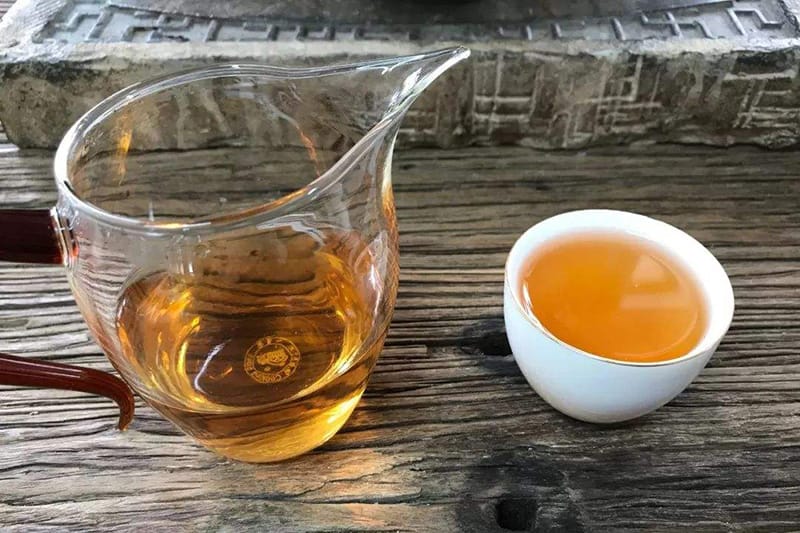
Classified By The Shapes
Except for the different fermentation way, various shapes of Pu-erh tea also confuse factors to tea lovers. Even though the shapes look strange, they have reasonable and are the primary way of classifying.
Tea Cakes
Pu-erh tea cakes are the most common. Traditionally, each cake weighs 357g, equal to 7 Liang in the old Chinese unit of measurement. Then 7 cakes for a package. 7×7=49, which means the family’s prosperity in Chinese culture. And this packing specification also makes the measure job more effortless in the old-time.
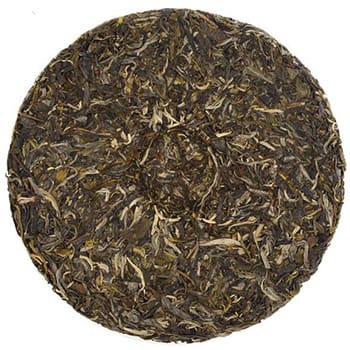
Tuo Cha
Tuo Cha also is a typical Pu-erh shape. It looks like a bowl with a thick wall, most weight 100g or 250g. This shape may come from the reason that it’s easier to compress-shaping and package them into a set by a straw rope.
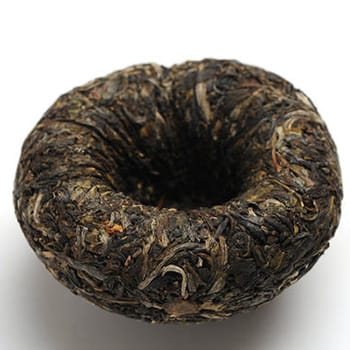
Gold Melon
Gold Melon(Jingua), also called block tea or head tea, a rare Pu-erh shape. It got some stripes on the surface and looked like a pumpkin. In the old-time, this type of Pu-erh only served the emperor. So it was made from the leaves and buds with the highest quality. After aging, the color will turn to gold; that is why it is called Gold Melon.
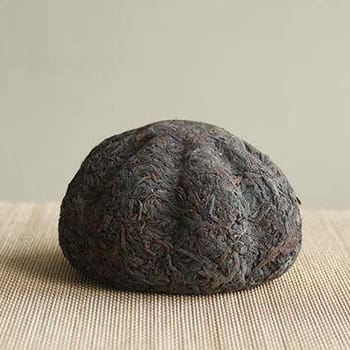
Tea Brick
Most other dark tea like to be compressed into a tea brick, square, or rectangle. The Chinese invented ancient printing technology, and the tea masters love to use it on compressing tea brick. So you can often see some Chinese characters about the leaves specification or blessing on the brick.
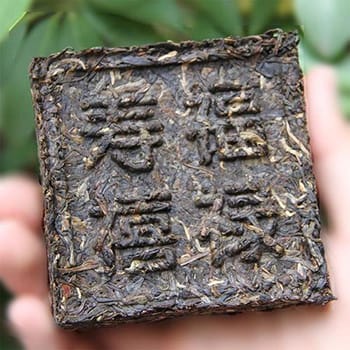
Mushroom Cha
Mushroom Cha is also called tight tea. It looks like a mushroom and usually for the Tibetan for making butter tea.
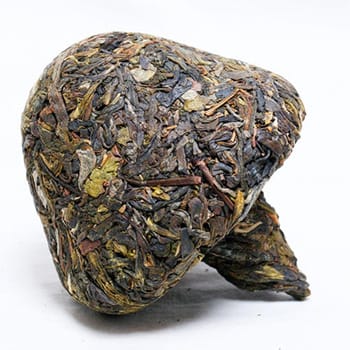
Old Tea Block
It’s a Pu-erh tea style which becomes popular in recent years. It comes from the piling step of ripe Pu-erh processing. The rough tea, which it takes as the basic, contains some tender buds and leaves, with a high pectin content. During the microbial fermentation, they will intertwine and form a block. Tea masters will pick them up and sent them to be further processing, to make the old tea block. It’s a kind of high-quality ripe Pu-erh but looks ugly.
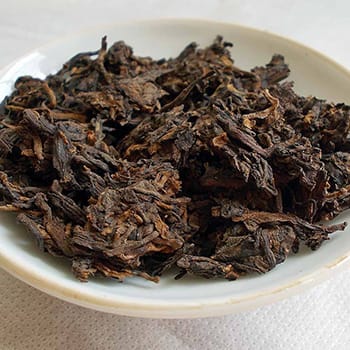
Popular Factors Except For Lose Weight Benefit
About the Pu-erh tea benefits, most famous is about the losing weight. Related research suggested that Pu-erh tea is doing better at losing weight than other types of tea. The most obvious is if you have a cup of Pu-erh after a greasy diet, raw or ripe is OK, you will find your oral fresh again.
But the merchants overstates the loss weight benefit of Pu-erh; in fact, you can not make the belly gone only by drinking it. And on the treatment of obesity, Pu-erh tea only can offer the auxiliary effect.
So why Pu-erh tea regarded as the Chinese most favorite?
First, Pu-erh tea flavor is more suitable for the Chinese taste than green tea and black; they just like it. Then, Pu-erh is more resistant to brew than other tea types. It makes the tea party for friendship easier; you don’t need to replace the leaves frequently. And, compared with the loss weight benefit, Chinese people prefer its helping digestion and stomach nourishing effects.
One thing I think is the most important is the love of aging stuff’s value by people. Like wine, many of them worldwide will be priced by the vintage; the older, the more expensive. In China, except for the Pu-erh and wine, many foods also can appreciate through aging. The most common is the dried tangerine peel, which is good for the throat and the best seasoning for Pu-erh brewing.
People believe that the longer the Pu-erh aging, the more benefits it will get from the microbial fermentation, even though it has not exact scientific proof. But when a Chinese serving you with a Pu-erh tea, which he has been aging at home for more than 10 years, it means you are a cherished friend to him.
And analyze from the commercial view, the Pu-erh trends also consistent with the characteristic of suitable for aging. Take green tea as an example; the more tender, the better, and it cost more. But it got a short shelf-life; if you don’t finish consuming it in time, it will go bad and make waste. It has limited the green tea market to some extent because the human appetite has a limit. And the Pu-erh is suitable for long time storage, it doesn’t have this problem.
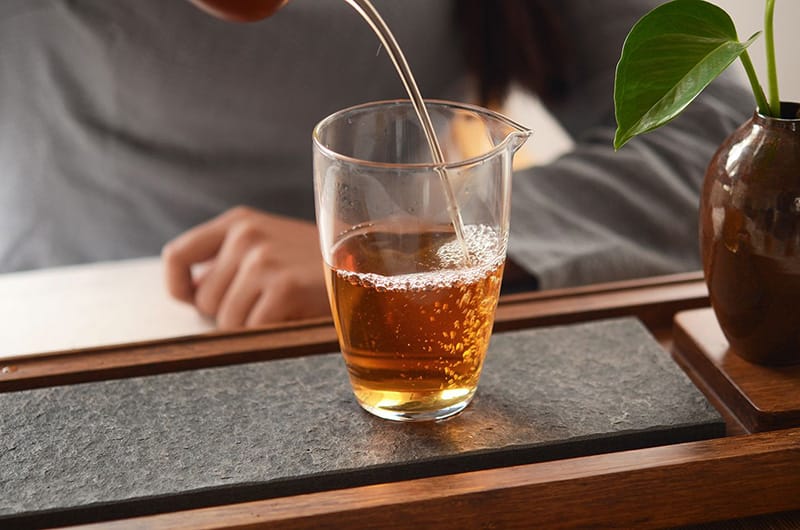
Proper Aging Way
A proper store way, or you can say the aging way, is significant after buying a Pu-erh tea. After all, aging is the soul of Pu-erh. A proper method can let you got different feelings from the same cake every time you brew it. And there is some difference between Pu-erh and other teas on storing job, mainly are the followings:
Air Circulation
This is an essential point in Pu-erh storing. Different from green and black tea, which need a nearly sealed space. An air circulation environment means a lot to Pu-erh. Because during the aging, the fermentation is mainly proceeded by the microorganism, and these little things need enough air to survive.
An air circulation environment can offer enough oxygen to the microorganisms who live in the Pu-erh tea, help them doing the fermenting job continuously. But one thing that needs to be paid attention to is not letting the air circulate too fast, like a strong wind, making the tea lose its fragrance. The best way is to put the tea in an incomplete-sealed, smell-less box or cabinet; a cardboard box is the most tea lovers’ choice.
Humidity
The level of air humidity will affect the Pu-erh fermenting speed. During the piling of ripe Pu-erh processing, tea masters speed the fermenting up by keep adding water into the leaves. But never try to imitate them, they are professional and with strict date support. To store Pu-erh tea in a too wet environment will make the microorganisms breeding too fast. The most common side effect is the leaves will go moldy.
The humidity of the Pu-erh storing place should be control under 75%. Typically, people who live in a humid region will buy a container with a humidity controller for aging Pu-erh tea. If you live in a dry area, a small tip is to place a cup of water around the leaves, but take care of it and not let it down.
Temperature
The temperature of the Pu-erh tea storing environment should not be too high or low. Except you live in a place with an extreme climate, the normal temperature is just fit. And the best is to control it between 20 to 30℃. Too cold will not affect the leaves much but fermenting slower; Too hot will speed it up and make the leaves taste sour.
Light
Light is often an overlooked factor. Direct sunlight not only heat the leaves, and the UV also make the photochemical reaction. A long time under sunlight will make the Pu-erh color and flavor go bad. So remember to store it in a dark place.
How To Make Pu-erh Tea
It’s a little challenging to make Pu-erh tea. First, most of them are compressed tea, and you gonna need a small knife to take the leaves. Pry the leaves you need on the cracked place; usually, it is the center. Then packing the Pu-erh cake well again to pretend it from damp(typically, there will be a rice-paper package.)
About the teaware choice, a set of purple clay teaware is a senior tea lover’s favorite. Because Pu-erh tea is resistant to brew, and purple clay teapot got an excellent insulation performance, which can extract the taste from leaves better. But it is hard to clean. So to most people, porcelain teawares may be an excellent choice. And remember to pre-heat them before brewing.
Due to it been a long time aging, Pu-erh will catch some dust inevitably. So after you put the leaves into the teapot, add hot water, steep for 3-5 seconds, then pour the wastewater out. Pu-erh tea usually needs to clean twice. And it can help the leaves spreading, make the taste become easier dissolving in the coming brewing.
After washing the leaves, add 95℃ or boiling water in, cover, and steep for 7-10 seconds. Pour the infusion into the fair cup to equalize the concentration. Then pour it into the teacup for serving. Pay attention to the infusion color; Pu-erh is resistant to brew, so after 4 brews, you can consider suitably extend the steeping time.
For raw Pu-erh tea, most of the time is just brewing alone. And for the ripe one, most people prefer to add other seasonings for flavoring. The most common is dried chrysanthemums and tangerine peel.
Brewing with dried chrysanthemums, Pu-erh becomes full of floral, astringent will be gone, and tastes smoother. If with dried tangerine peel, it will get fruity, lightly sweet, and sour. Some tea masters will put the ripe Pu-erh into a dried tangerine for sale to get more fruity.
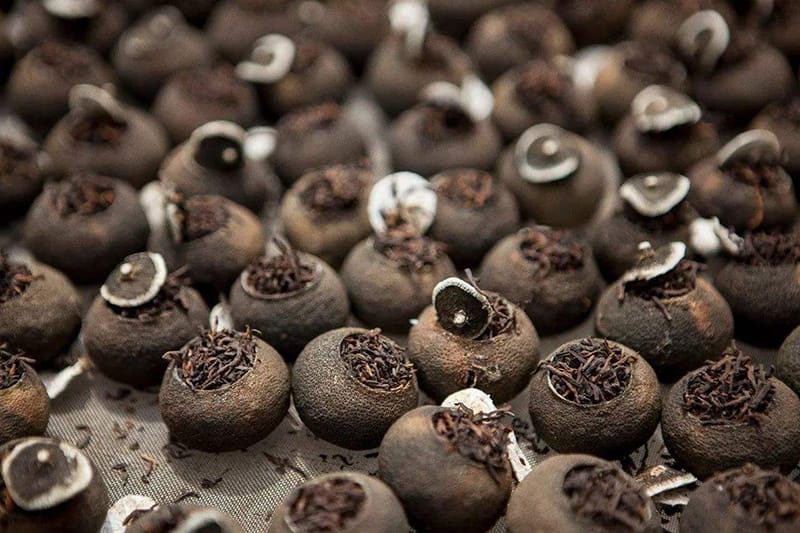
Even though ripe Pu-erh tea has a stomach nourishing benefit, and it also tastes awesome. Personally, I thought its taste would be addictive. There was a time I like to make a pot of strong ripe Pu-erh in the morning; it is really an enjoyable thing. But after some days, I got a stomachache and felt the acid reflux. So please do not drink it too much at once or make the infusion too strong.